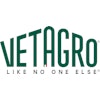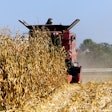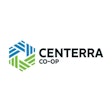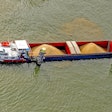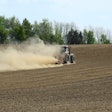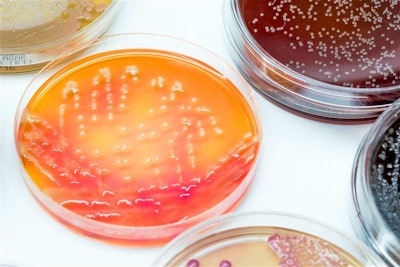
Operative sanitation and environmental monitoring programs are fundamental to food safety and the reduction of biological, chemical and physical hazards in poultry processing plants.
While a poultry producer’s sanitation routine should incorporate both routine and non-routine procedures, mastering the basics of routine sanitation is essential, according to OSI group senior director, global sanitation, James Davis.
"You can't get into a comprehensive non-routine master sanitation schedule until you get the basic, routine sanitation done," Davis said during the 2025 Food Safety Summit.
Seven steps to routine sanitation in processing plants
According to Davis, a routine wet sanitation process involves seven steps:
- Prepare the area and dry clean – This initial stage, considered one of the most important steps, involves equipment lockout/tagout, proper disassembly and debris removal.
- Pre-rinse – Remove remaining soils with hot water, working from top to bottom. Davis stressed the importance of proper water pressure to prevent spreading debris. "The higher the pressure, the more likely you're going to be pushing debris, soils and water into harborage points."
- Apply detergent and scrub – Use appropriate chemistry for soil types and ensure that the foam adheres to surfaces. "Foam the entire room, not just the equipment," Davis stated.
- Post-rinse and self-inspect – Use flood rinsing at the proper temperature to remove soap and dissolved soils while minimizing condensation. Workers should thoroughly check their work at this step.
- Prepare for pre-operational inspection – Workers should change into clean outerwear and remove standing water.
- Pre-operational inspection – Equipment should be cycled to inspect all surfaces. During visual inspections, adenosine triphosphate (ATP) bioluminescence tests should be used to detect non-visible soils.
- Sanitize – Use a flood method on equipment to ensure sanitizer reaches cracks and crevices. A foam application should be used for infrastructure surfaces.
Effective sanitation extends beyond routine cleaning
Once routine cleaning procedures are successfully implemented, producers should start to focus on cleaning activities that occur on a non-daily basis, known as a master sanitation program.
According to Davis, developing an effective master sanitation schedule requires understanding both equipment design and risk assessment. To do so, Davis recommends that producers:
- Determine the food safety risk of their process, such as the relationship between cooked and raw areas.
- Evaluate processing equipment for hygienic design non-compliances.
- Analyze each non-compliance for food safety risk level.
- Determine the appropriate periodic equipment cleaning (PEC) requirements.
- Update the master sanitation schedule with detailed procedures.
"The frequency of non-routine cleaning tasks should be determined by data, not solely by production schedules or personnel availability," Davis added.
The importance of hygienic design
Davis emphasized that hygienic design evaluations will help producers identify areas that require special attention during cleaning. For older equipment with design flaws, more extensive disassembly may be necessary during cleaning.
"The better the hygienic design, the fewer master sanitation schedule tasks you need," Davis stated.
Additionally, sampling of normally inaccessible surfaces before and after cleaning helps determine the appropriate cleaning frequencies. Total bacterial count (TBC) targets should be based on finished product micro limits, shelf-life restrictions and historical pre-operational outcomes, Davis continued.
To help ease the sanitation process, Davis urged processors to maintain cleanliness during operations and have special control procedures for unexpected situations such as overhead leaks or drain backups.
Environmental monitoring is verification, not control
According to Eric Ewert, food safety and quality zone lead, lab and technical services department, Kraft Heinz, a comprehensive environmental monitoring program should include different types of data collection to drive improvements in sanitation across three main categories:
1. Pre-operational monitoring – Verifying sanitation effectiveness through ATP swabs, visual inspection, indicator organisms and pathogen testing.
2. Utilities monitoring – Ensuring water, compressed air, environmental air and steam are not sources of contamination.
3. Operational monitoring – Confirming hygienic conditions are maintained throughout production runs.
Ewert added, "Commonly, you'll see aerobic plate count (APC) or some type of spoilage indicator (swab) in zones one and two (food contact and near food contact surfaces), typically four hours into a run and towards the end of the run to evaluate differences in microbial load over time."
While environmental monitoring programs are essential for verifying sanitation practices and preventing product contamination, Ewert stressed that they should not be used as direct control against food safety pathogens.
Ewert stated, "environmental monitoring verifies the effectiveness of overall hygienic practices in a facility and provides information to protect your product from contamination."
"Environmental monitoring is not a control. It's there to verify that your cleanliness is being maintained, whether from a sanitation perspective or during operations,” Ewert continued. "The act of collecting a swab doesn't protect your product – other prerequisite programs and sanitation effectiveness prevent contamination."
Investigating positives using "seek and destroy"
When producers get a positive indicator for a type of bacteria or pathogen, Scott Oakland, corporate staff engineer, food safety and quality, Hormel Foods, recommends that poultry producers follow the “seek and destroy” method, which involves stopping production, if necessary, and not immediately cleaning.
"The first reaction should be not to clean – treat it like a crime scene. Don't scrub it," Oakland emphasized. "The goal is to identify the root cause for effective corrective action."
The "seek and destroy" methodology includes:
- Aggressive sampling with intent to find the harbor areas.
- Identifying vectors and sources of organisms, such as drains, floors or ceiling leaks.
- Implementing effective and sustainable corrective actions by determining what caused the issue. This may involve team member interviews, work order reviews, examining equipment or evaluating compressed air systems.
Additionally, Oakland said that these investigations should involve a cross-functional team that involves maintenance, sanitation, operations, food safety and quality, corporate representatives, and even chemical providers.
"Seek and destroy is a team sport," Scott continued. "I've seen events where people pull that lever and say it was sanitation's fault, walk out the door and have them clean. That's the wrong answer."
After identifying the root cause, Oakland suggested corrective actions such as shock sanitizing, implementing deep cleaning protocols and updating the master sanitation schedule to prevent recurrence.

